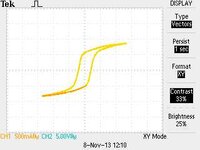cupoftea
Advanced Member level 5
Hi,
We want a 50Hz, 240VAC mains transformer to supply 24V at 1A
We therefore selected the following 50VA transformer (504246)
https://docs.rs-online.com/c4ae/0900766b816919e8.pdf
its spec’d for 230VAC and 2*9V sec
However, the VA rating needed depends on the magnetising inductance, which depends on the primary inductance. However, the primary inductance isn’t stated for the above transformer.
So how can we work out if the VA rating is enough for the output power required?
I mean, if you observe the attached, then the transformer with a primary inductance of just 200mH ends up having a power factor of just 0.03. As such, it needs a VA rating of 860VA to supply the 24W output.
LTspice and PDF schem attached.
.....____
A mains transformer based solution has far better mains transient withstand than an offtheshelf SMPS. Also, it is far less EMC noisy. Also, it allows you to select your own electrolytic smoothing capacitors, and so you can select loads of really high quality 125degC ones, and so have really low ripple current in each cap, which means the product will last for decades.
We want a 50Hz, 240VAC mains transformer to supply 24V at 1A
We therefore selected the following 50VA transformer (504246)
https://docs.rs-online.com/c4ae/0900766b816919e8.pdf
its spec’d for 230VAC and 2*9V sec
However, the VA rating needed depends on the magnetising inductance, which depends on the primary inductance. However, the primary inductance isn’t stated for the above transformer.
So how can we work out if the VA rating is enough for the output power required?
I mean, if you observe the attached, then the transformer with a primary inductance of just 200mH ends up having a power factor of just 0.03. As such, it needs a VA rating of 860VA to supply the 24W output.
LTspice and PDF schem attached.
.....____
A mains transformer based solution has far better mains transient withstand than an offtheshelf SMPS. Also, it is far less EMC noisy. Also, it allows you to select your own electrolytic smoothing capacitors, and so you can select loads of really high quality 125degC ones, and so have really low ripple current in each cap, which means the product will last for decades.
Attachments
Last edited:

